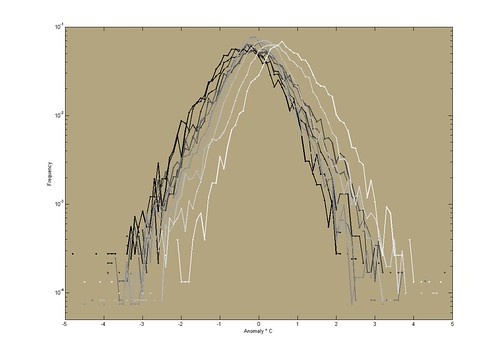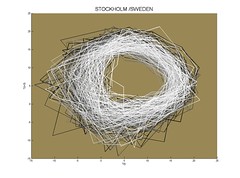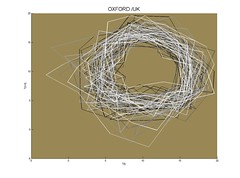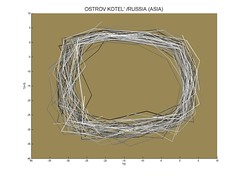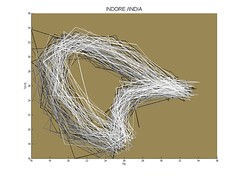December 29, 2009
A contribution of smut to the Internet
Rule 35 states that "If there is no porn of it, it will be created".
During a discussion about this (where a far too innocent friend lost several bets on the non-existence of various erotic subjects) I realized that there was no dodecahedron porn. Cube porn does exist, but as far as I could discern nobody had yet depicted the erotic potential of that lovely {5,3} polyhedron. This has now been corrected.
In addition, since this picture depicts two genus 11 surfaces going at it, it is homosexual pornography. Generalizations to higher dimensions, Archimedean solids and duality sex are left as an exercise for the student.
December 18, 2009
Paradox genetics
 Irregular Webcomic! #2518 brings up the "my own grampa" paradox - if you go back in the past and have a child, you can become your own grandparent.
Irregular Webcomic! #2518 brings up the "my own grampa" paradox - if you go back in the past and have a child, you can become your own grandparent.
There is an interesting genetic issue here. Around one fourth of your genome will be from yourself. So what genes will be there? At first look, clearly they could be *anything*, since they are not constrained by ancestry. They might be completely random. In fact, they are far more likely to be random or alien than human, since the number of human-like genomes is far, far smaller than the number of random genomes.
However, there are some boundary conditions. These genes must not only produce a viable time traveler, they must also produce a time traveler who can get a fertile child with (presumably) a human. This seems to introduce a rather powerful constraint: the arbitrary genome cannot deviate strongly from a typical human genome.
There is still room for plenty of arbitrariness there, though. One way of looking for time travelers would be to look for people with a very high concentration of unique SNPs - they are potentially descendants of self-related time travelers who introduced a large bunch of arbitrary differences into the genome [*].
This issue is related to the problem of computation with closed timelike curves: if computers are allowed to get information from the future, can you get information from "nothing"? After all, you could have a program receiving (say) a blueprint for a making transparent aluminum from the future, check that the blueprint is correct, and if so send it back into the past. This way you would get information you don't know how to produce yet can check the correctness of "for free". This computation scheme was originally proposed by Deutsch as causal consistency computing in 91 (another early version was by Hans Moravec), and he called the phenomenon the "knowledge creation paradox." Dave Bacon showed that causal consistency allows solution of NP complete problems and Scott Aaronson and John Watrous showed that both classical and quantum time-computers are equivalently powerful - both belong to the class PSPACE. See Aaronson's excellent lecture notes for more on this.
This suggests that putting the right selection constraints on your offspring/parent can produce any necessary mutation. Imagine that your offspring/parent catches an illness (before reproducing) that is normally 100% fatal. They will however have a mutation that will save them, since otherwise the situation would be inconsistent. Of course, quantum mechanics might also conspire to prevent them from encountering the illness, but immunity-producing random variations in the genome are likely to be more probable than avoiding a common virus (compare this to the problems in quantum suicide computing, where the likelihood of the machine breaking down needs to be held much lower than the likelihood of finding a solution). The above beneficial mutation case of course applies to poisons or anything that would prevent them from reproducing. So if you, devious grandparent-harassing time traveler as you are, put your parent/offspring into a deathtrap that can only be escaped by having some superpower, then the amazing power of causal consistency will have given them it! Not only that, the same is true for yourself - until the moment you reproduce.
[* Multiple parenthood a la Heinlein's "--All You Zombies--" has no constraints at all beyond the time travel loops. That produces a reference class problem, since there is no reason for the person to be even human (or an observer). Unless external events always kill off/remove time travelers that look alien. ]
December 16, 2009
Significant anomalies
In my last climate data posting I had managed to load the data into Matlab and plot some of it. Now I have extended the scripts to organize the data in time and space so that I can actually check whether there is a trend or not.
Here I have plotted the anomalies (the difference of each weather stations data from a mid-century reference period) averaged across different latitude bands of the world. There certainly seems to be a trend in all bands (and in the total average), but since stations come and go there could be bias. The shakiness of the early Antarctic curve also points at the problem of statistical significance: just how reliable are the aggregate measurements?
Looking instead of how the anomalies distribute themselves across time we get this. Here I have plotted the frequency of anomalies of different sizes from all stations in a given decade. The overall shape is nicely parabolic - they are roughly normally distributed. This is good for making statistical inference. Also note that the mean seem to be creeping upwards.
The next step was to write a script that gathered all data from stations inside a grid together, so I could run a real statistical significance test. I used a 10x10 degree grid, and compiled the yearly anomalies within each grid cell. I could then apply a Student's t-test to these to see if the mean anomaly was significantly different from zero.
and here are the cells that are significant:
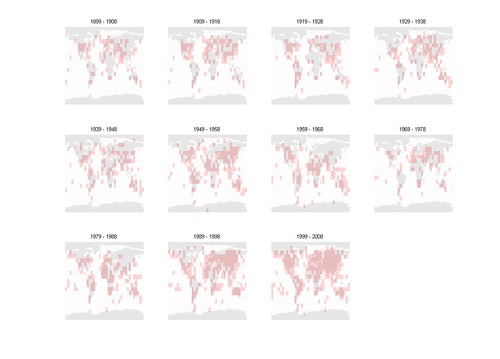
Finally, here are the mean anomalies:
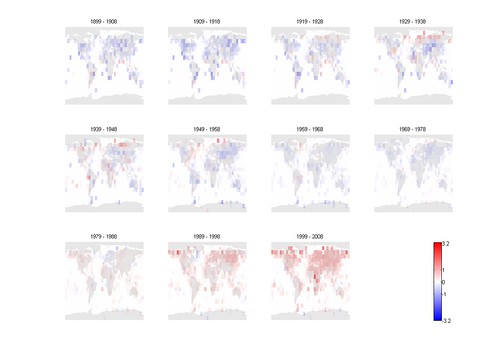
The result is pretty clear: this dataset is getting significantly warmer especially in the northern hemisphere over the last two decades.
Of course, this is very much a hobby experiment. I have used yearly anomalies rather than monthly, and this might mess up things. My Matlab code is messy and ugly, and I am not that great a statistician, so it is not at all unlikely there are bugs here. Still, it is nice to get to know a real dataset intimately and to figure out how to squeeze information from it.
Looking at there reference for the dataset this is a subsample of [P. Brohan, J.J. Kennedy, I. Harris, S.F.B. Tett and P.D. Jones, Uncertainty estimates in regional and global observed temperature changes: a new dataset from 1850. J. Geophys. Res, 111, D12106, doi:10.1029/2005JD006548 (pdf 1.2Mb)] there are still intriguing questions to pursue. My own favourite issue is the urban heat island effect: as cities have grown, they have likely biased some weather stations. Controlling for this is non-trivial, and there are disagreements on how big the effect is. The paper has an interesting argument that adjustments (due to this effect and other issues) should be normally distributed but the documented adjustments are bimodal. This is likely because small problems are not controlled for, while people correct for more obvious ones (there is a small bias towards negative adjustments due to the heat island effect). In any case, the paper fills in the missing part of a normal distribution and then uses this in its own uncertainty calculations. This seems to be a potentially problematic point, and it might be very interesting to figure out better ways of correcting for external biases and adjustments made in response to them. But that is for another day.
December 14, 2009
Value added lectures
 Two lectures from here: Future of Humanity Institute - Global Catastrophic Risks with Nick Bostrom and Human Enhancement: Bioliberation or Biothreat? with Julian Savulescu.
Two lectures from here: Future of Humanity Institute - Global Catastrophic Risks with Nick Bostrom and Human Enhancement: Bioliberation or Biothreat? with Julian Savulescu.
The interesting thing is the flash-based lecture player, which has a few cool features. Besides showing the slides and lecturer at the same time, it allows showing sectioning of the talk and links to extra references.
Giving good lectures is an art (and no player can ever make a bad talk good), but it is interesting to consider how we can use this kind of recording to improve talks. Good props clearly help a talk, like seen in Gerald Sussman's enjoyable talk about the electrical engineering view of a mechanical watch (real clockwork, model clockwork, an oscilloscope connected to a circuit). One could easily imagine this talk enhanced by links to something like Mathematica where one could play around with the blackboard equations, a simulator of the mechanical or electronic systems and of course links to further papers or pages. On the other hand, this is divergent information - a good talk is usually convergent, bringing attention and understanding to a few key points. The extra stuff is useful for testing or making this understanding intuitive, or diverging to related things - but only once the basic ideas have been conveyed.
December 13, 2009
Digging into data
The Met office has now released a lot of climate data, setting off a frenzy of amateur visualisation and analysis.
I could of course not stay away, so here are my first results.
Plotting the locations of weather stations in the database shows that they are unevenly distributed:
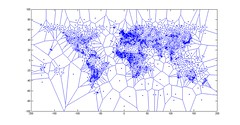
In fact, they are also unevenly distributed in time. Michael Scheiben has done a nice video of the data across time, showing how the stations come online - and go offline. For example, decolonization in the 1970s meant that Africa lost a lot of its weather monitoring. Just plotting individual station averages shows a broadening from Western Europe towards the arctics and tropics.

This of course means that just taking plain averages across the station data will not work, since there will be more tropical (and arctic) stations close to the present than at the start. And the stations are on different altitudes too.
Another obvious thing to plot is the monthly averages as a polar plot. I used different color for age, hoping to see clear trends:


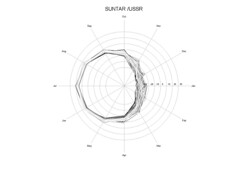
While this kind of plot makes it clear that winters have a greater variance than summers (at least in the northern temperate and artic zone) overall trends was relatively hard to make out.
I hence turned to one of my old favorites, the time delay plot. Usually used to reconstruct strange attractors it just consists of plotting X(t) vs X(t+delta), where delta is a suitable delay. In this case 3 months is ideal. The result is a graph that shows more detail of the local temperature pattern:
Stockholm and Oxford show the same kind of temperate, somewhat fuzzy dynamics. A bit more variance in winter, but not much.
Siberia is much more angular or has high-variance winters. Central Antarctica is equally angular.
East India showed some noticeable trends, for reasons I do not yet understand (note that these two go in opposite directions). One reason why trends is more obvious here may be a smaller yearly variation in temperature, which otherwise hides trends in the above plots.
North India has a very characteristic shape that I think is due to the monsoon season. This is repeated across the monsoon area, and a somewhat similar pattern shows up in Mali - presumably the rainy seasons of Africa are a close dynamic counterpart.
Next step consists of merging data from the different stations to get estimates of how yearly temperatures change.
December 09, 2009
A long and productive life
 This is why life extension is not just a moral thing to do, but also macroeconomically sensible: Long-term economic growth stimulus of human capital preservation in the elderly - a new paper in PNAS.
This is why life extension is not just a moral thing to do, but also macroeconomically sensible: Long-term economic growth stimulus of human capital preservation in the elderly - a new paper in PNAS.
While they are most interested in the US health care system (seems to be something in the air :-) the real importance is the understanding that preserving human capital is worth a lot. Numbers like 4,057 billion dollars by 2028, for example. And they are not assuming any radical life extension, just a bit better health increasing the labour pool.
Once politicians in Europe seriously realize what working anti-ageing treatments could do there is a real risk that we will see hype and funding bloat. After all, slowing ageing is almost exactly what the EU needs (and immigrants[*], of course).
[ * Economy fact for today: worldwide remittances 2006 were $250-401 billion. Development aid was about $100 billion. So remittances are 2.5 to 4 times as large - and directly targeted at the people who need the money the most. ]
December 04, 2009
Global thinkers (except in Sweden)
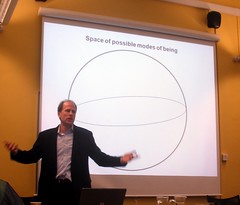 Foreign Policy has made a list of the top 100 global thinkers. I'm happy to say that Nick Bostrom is #73 on that list, just over Gordon Brown (and just below Ray Kurzweil and Jamais Cascio).
Foreign Policy has made a list of the top 100 global thinkers. I'm happy to say that Nick Bostrom is #73 on that list, just over Gordon Brown (and just below Ray Kurzweil and Jamais Cascio).
The amusing thing (beside that I have the chance to work with such a great guy) is the coverage in Swedish media. Svenska Dagbladet makes a big thing that Hans Rosling at KI is the only swede on the list. Dagens Nyheter also fails to notice Nick. Seems they do not keep track of their Swedish geniuses very well.
December 03, 2009
Celebrity brain sliced, film at 11!
 The Brain Observatory - In Memory of H.M. webcasts the microtome slicing of H.M.'s brain in realtime. I guess this is a natural step for one of the "superstar patients" of neuroscience.
The Brain Observatory - In Memory of H.M. webcasts the microtome slicing of H.M.'s brain in realtime. I guess this is a natural step for one of the "superstar patients" of neuroscience.
The experience is strangely voyeuristic. We have come very far from the Trojan Room coffee pot of the early 90's.
The idea of sponsored histological glass slides is also odd. But any way to get money to research, I guess.
December 01, 2009
It works for bruises in Germany!
 Practical Ethics: Diluted evidence: is there anything special with homeopathy? - I blog about the committee meeting on the evidence for homoeopathy I attended last week in Westminster. Hurray for Ben Goldacre and Evan Harris.
Practical Ethics: Diluted evidence: is there anything special with homeopathy? - I blog about the committee meeting on the evidence for homoeopathy I attended last week in Westminster. Hurray for Ben Goldacre and Evan Harris.
It was an interestingly mixed audience - homeopathy supporters and us, a bunch of scientists participating in the Royal Society pairing scheme.
The things that really struck me in Westminster was how much was going through the motions. Partially this was of course due to the traditions of Parliament and the imminent election. But I wonder how many man-hours of actual decisionmaking and actual communication happen in Parliament per day. Definitely some, and it is partially augmented by assistants and departments, but it is likely a very small fraction. On the other hand, what would a government that actually used all its brainpower do? We have never seen such a beast.


